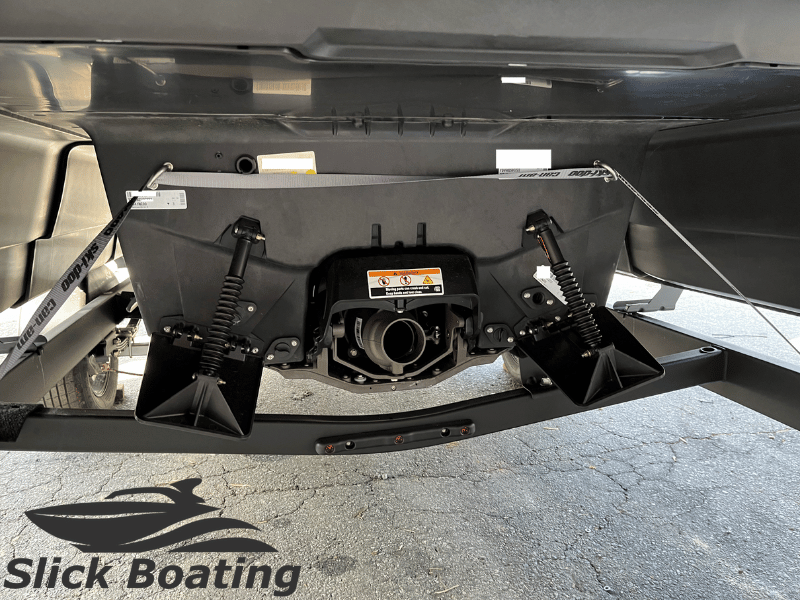The Sea-Doo Switch is a new idea, it’s a jet-powered pontoon boat, but this has people asking many questions.
Since it’s based off Sea-Doo watercraft, does this mean the Switch does not have reverse or neutral? Not only does the Switch have all of that, but it also has something other boats don’t!
Does The Sea-Doo Switch Have Reverse?
The Sea-Doo Switch does have reverse just like any other boat.
The only thing that is different is the direction the boat goes in reverse.
In forward or reverse, the direction you turn the handle bars is the direction the nose of the boat goes.
And yes, the Sea-Doo Switch uses handlebars instead of a steering wheel, and it’s for a good reason, as explained soon.
Does The Sea-Doo Switch Have Neutral?
The Sea-Doo Switch does have a neutral, but it’s different from other boats.
Since the Sea-Doo Switch is a direct drive system that uses a jet drive, a bucket is used to redirect the water to make you go forward or reverse. This means neutral is in between forward and reverse.
This is a huge perk because it keeps you controlling the boat at all times. Where other boats slip into and out of gears, leaving you a brief moment with no control, the jet drive system is always processing water, and you never lose control.
With this style of control, it also gives us something that not other boats on the market has… brakes!
The Sea-Doo Switch Has Brakes!
Yes, you’re reading that right. You can buy a boat with brakes!
The Sea-Doo Switch comes with brakes on ALL models they sell along with forward, neutral, and reverse.
With the brakes, it makes it easy to control the boat and dock it compared to any other boat. The Sea-Doo Switch is the best Pontoon boat for a beginner, hands-down. The control you have over this boat with just at your fingertips is night and day better than any other boat on the market.
How To Drive The Sea-Doo Switch
Driving a Sea-Doo Switch is very similar to driving a jet ski, but much bigger.
You start in neutral, and the right trigger is forward, and the left trigger is reverse and braking.
You also have different driving modes for pull sports, ECO and more to fine tune the ride you want. You also have trim like any other boat so you can adjust for the waves and the people you pull behind your Switch.
To learn more about driving the Sea-Doo Switch, check out this video:
Sea-Doo is really hitting it out of the park with this boat and bringing new life to the pontoon boating world!
How Reliable Are Sea-Doo Switch Engines?
The Sea-Doo Switch uses the same engine as the Sea-Doo PWCs, and the 4-Stroke engine block dates back to 2002!
Sea-Doo did have some issues with their superchargers around 2007, but by 2012 they were improved and with 2016 being the next leap for their engines it just keeps getting better. The Switch uses the 2016 engine block and has been the best marine engine Sea-Doo has ever made, and they still keep enhancing it!
The Sea-Doo Switch is still new, so we have not seen how many hours people are getting, but it’s the same engine block since 2016, and I’ve seen people put 1,000 hours on them without major issues.
The average person will put about 50 hours a year on their boat, so in 10 years you’ll be kissing 500 hours with room to spare!
How Durable Is The Sea-Doo Switch Hull?
The Sea-Doo Switch uses a Polytec hull, which is different from fiberglass.
Polytec is not new, Sea-Doo released it for their Sparks in 2014. They later added it to the new GTI line up completely in 2020 in a new generation hull that was stronger and more reinforced.
The Switch takes the GTI hull and expands it and strengthens it even more, and they add two side toons (outriggers) for stability. Most people don’t know this, but the center toon of the Switch is the Sea-Doo’s GTI hull, which is one of their most reliability models. Just Google “the most reliable Sea-Doo models” and you’ll see the GTI and Sparks come up.
Yes, the hull is a type of plastic, but fiberglass is a type too. It’s all a part of the resin family, and both use mesh to strengthen them. The perk with Polytec is that it’s lighter and more flexible.
Think about it, fiberGLASS and Polytec is plastic, If you drop a glass plate vs a plastic one which one is going to crack?
I would say Polytec is the future for all boats, but Sea-Doo has that patent on lockdown. Other boat manufacturers would love to use something that is strong, cheap, and doesn’t swell like fiberglass when exposed to water. Fiberglass can blister, but this is not a thing with plastic.
